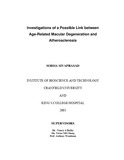JavaScript is disabled for your browser. Some features of this site may not work without it.
| dc.contributor.advisor | Bailey, Tracey A. | |
| dc.contributor.advisor | Chong, Victor N. H. | |
| dc.contributor.advisor | Woodman, Anthony C. | |
| dc.contributor.author | Sivaprasad, Sobha | |
| dc.date.accessioned | 2006-03-20T16:56:05Z | |
| dc.date.available | 2006-03-20T16:56:05Z | |
| dc.date.issued | 2005-08 | |
| dc.identifier.uri | http://hdl.handle.net/1826/1013 | |
| dc.description.abstract | Increasing epidemiological evidence suggests a link between atherosclerosis and age-related macular degeneration (AMD). There are two main hypotheses that explain the link. One hypothesis is that AMD and atherosclerosis are tissue responses to injury. The ‘Response to Injury’ hypothesis defined as ‘abnormal reparative response to chronic, recurrent injurious stimuli’ speculates that AMD and atherosclerosis may be cellular effects of chronic or repetitive risk factors. The second hypothesis suggests that AMD is secondary to vascular insufficiency caused by atherosclerosis. The research in this thesis is an attempt to test these hypotheses to better understand the correlation of AMD and atherosclerosis. Both basic and clinical science approaches are employed. Part one focuses on the role of extracellular matrix (ECM) proteins in the pathogenesis of AMD. Both serum elastin derived peptides (S-EDP) and matrix metalloproteinases (MMP-2 and MMP-9) are raised in subjects with atherosclerosis. The circulating levels of these matrix components were tested in patients with varying degree of severity of AMD and compared to age-matched controls. Both S-EDP and MMP-9 were found to be significantly raised in patients with AMD, while MMP-2 did not correlate with it. S-EDP is elevated in abdominal aortic aneurysm (AAA), a manifestation of atherosclerosis. Since S-EDP correlates with size of both AAA and severity of AMD, this research looked at a possible association between the two diseases but found no significant correlation. The second part of this thesis investigates whether chronic inflammation may explain the co-existence of the two diseases. With the recent finding that Complement Factor H (CFH) is related to AMD, this study focused on the role of complement activation in AMD, speculating that the final common pathway of both diseases may be chronic inflammation. Increased systemic complement activation was found in neovascular AMD, as assessed by the measurement of C3a des Arg. Part three of this thesis tested the second hypothesis that AMD is secondary to the vascular insufficiency caused by atherosclerosis. Both the choroidal blood flow and retinal vessel calibre in patients with asymmetric AMD were studied and no significant changes in ocular haemodynamics were noted. In conclusion, this research favours the concept that atherosclerosis and AMD are parallel responses to chronic, recurrent injurious stimuli, with extracellular matrix remodelling and probably inflammatory response being the common cellular responses. This research did not find any significant ocular haemodynamic changes in subjects with asymmetric AMD. | en |
| dc.format.extent | 2641205 bytes | |
| dc.format.mimetype | application/pdf | |
| dc.language.iso | en | en |
| dc.publisher | Cranfield University | |
| dc.title | Investigations of a possible link between age-related macular degeneration and atherosclerosis | en |
| dc.type | Thesis or dissertation | en |
| dc.type.qualificationlevel | Doctoral | |
| dc.type.qualificationname | DM | |
| dc.publisher.department | Cranfield University at Silsoe |
